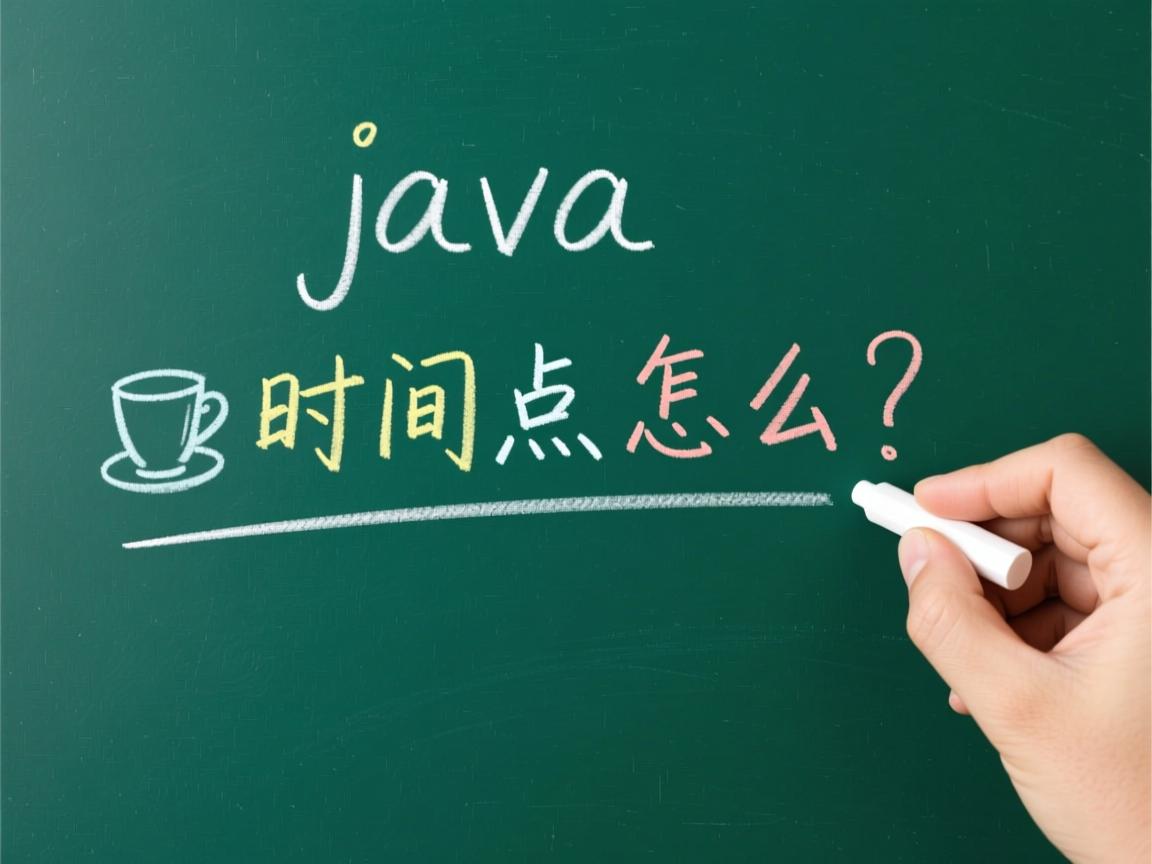上一篇
java时间点怎么定义的
- 后端开发
- 2025-07-09
- 4157
va中时间点通常以自1970年1月1日00:00:00 GMT以来的毫秒数表示,可通过java.util.Date或java.time包中的类来定义和处理
Java编程中,时间点的定义有多种方式,以下是详细介绍:
使用java.util.Date类
- 定义方式:
java.util.Date类是Java早期用于表示时间点的类,它的实例表示自1970年1月1日00:00:00 GMT以来的毫秒数,可以通过以下几种方式创建Date对象来定义时间点:- 获取当前时间:使用无参构造方法
new Date()可以创建一个表示当前时间的Date对象,其时间点为系统当前的时间。Date now = new Date();,此时now变量就代表了当下这个时间点。 - 指定毫秒数:通过传入一个长整型参数的构造方法
new Date(long date),可以创建一个表示从1970年1月1日00:00:00 GMT开始经过指定毫秒数的时间点。Date specificTime = new Date(1609459200000L);,这里的1609459200000L表示从历元开始的毫秒数,对应的时间点是2021年1月1日 00:00:00 GMT。
- 获取当前时间:使用无参构造方法
- 常用方法:
getTime():返回一个长整型值,表示该Date对象所代表的时间点距离历元的毫秒数。long millis = now.getTime();,通过这个方法可以将Date对象转换为对应的毫秒数,以便进行一些时间计算或存储等操作。before(Date when)和after(Date when):用于比较两个Date对象所表示的时间点的先后顺序。boolean isBefore = specificTime.before(now);,如果specificTime所代表的时间点在now之前,则isBefore为true,否则为false。
使用java.time.Instant类
- 定义方式:
java.time.Instant类是Java 8引入的新的时间API的一部分,它代表时间轴上的一个特定瞬时点,类似于时间戳,通常以UTC时间为基准,可以通过以下方式创建Instant对象来定义时间点:- 获取当前时间:使用静态方法
Instant.now()可以获取当前时间点的Instant对象,其表示的是当前的UTC时间。Instant currentInstant = Instant.now();。 - 指定时间戳:通过静态方法
Instant.ofEpochMilli(long epochMilli)或Instant.ofEpochSecond(long epochSecond),可以根据给定的从历元开始的毫秒数或秒数来创建一个特定的时间点的Instant对象。Instant specificInstant = Instant.ofEpochMilli(1609459200000L);,与Date类类似,这里的1609459200000L表示从历元开始的毫秒数,对应的时间点也是2021年1月1日 00:00:00 GMT(UTC时间)。
- 获取当前时间:使用静态方法
- 常用方法:
toEpochMilli():将Instant对象转换为从历元开始的毫秒数。long millis = currentInstant.toEpochMilli();,这在一些需要将时间点以毫秒数形式进行处理的场景中非常有用。compareTo(Instant otherInstant):用于比较两个Instant对象所表示的时间点的大小,返回一个整数值,如果当前Instant对象表示的时间点在otherInstant之前,则返回负数;如果相等,则返回0;如果在之后,则返回正数。int comparison = currentInstant.compareTo(specificInstant);。
使用java.time.LocalDateTime类
- 定义方式:
java.time.LocalDateTime类也属于Java 8的新时间API,它包含了日期和时间信息,但不包含时区信息,适用于处理不带时区的本地时间点,可以通过以下方式创建LocalDateTime对象来定义时间点:- 获取当前时间:使用静态方法
LocalDateTime.now()可以获取当前系统时区的本地时间点的LocalDateTime对象。LocalDateTime nowLocal = LocalDateTime.now();。 - 指定日期和时间:通过静态方法
LocalDateTime.of(int year, int month, int dayOfMonth, int hour, int minute)或LocalDateTime.of(int year, Month month, int dayOfMonth, int hour, int minute),可以指定具体的年、月、日、时、分来创建一个特定的本地时间点的LocalDateTime对象。LocalDateTime meetingTime = LocalDateTime.of(2023, 8, 20, 14, 30);,表示2023年8月20日14点30分这个本地时间点。
- 获取当前时间:使用静态方法
- 常用方法:
withYear(int year)、withMonth(int month)、withDayOfMonth(int dayOfMonth)、withHour(int hour)、withMinute(int minute)等:这些方法可以用于修改LocalDateTime对象的特定日期或时间字段,从而生成一个新的时间点的LocalDateTime对象。LocalDateTime newTime = meetingTime.withHour(16);,将meetingTime的小时数修改为16点,得到一个新的时间点。isBefore(ChronoLocalDateTime<?> other)和isAfter(ChronoLocalDateTime<?> other):用于比较两个LocalDateTime对象所表示的时间点的先后顺序,与Date类的类似方法功能相似,但参数类型不同,这里参数可以是任何实现了ChronoLocalDateTime接口的对象。boolean isBeforeMeeting = nowLocal.isBefore(meetingTime);。
使用java.time.ZonedDateTime类
- 定义方式:
java.time.ZonedDateTime类同样属于Java 8的新时间API,它在LocalDateTime的基础上增加了时区信息,能够更准确地表示特定时区的时间点,可以通过以下方式创建ZonedDateTime对象来定义时间点:- 获取当前时间:使用静态方法
ZonedDateTime.now()可以获取当前系统时区的带时区的时间点的ZonedDateTime对象。ZonedDateTime nowZoned = ZonedDateTime.now();。 - 指定日期、时间和时区:通过静态方法
ZonedDateTime.of(LocalDateTime localDateTime, ZoneId zone),可以将一个LocalDateTime对象和一个ZoneId对象组合起来,创建一个特定时区的时间点的ZonedDateTime对象。ZonedDateTime flightTime = ZonedDateTime.of(LocalDateTime.of(2023, 8, 20, 15, 30), ZoneId.of("Asia/Shanghai"));,表示2023年8月20日15点30分在亚洲上海时区的这个时间点。
- 获取当前时间:使用静态方法
- 常用方法:
withZoneSameInstant(ZoneId zone):该方法可以将当前ZonedDateTime对象所表示的时间点转换为另一个时区的相同瞬时点的时间表示。ZonedDateTime convertedTime = flightTime.withZoneSameInstant(ZoneId.of("America/New_York"));,将flightTime从上海时区转换为纽约时区的相同时间点。compareTo(ChronoZonedDateTime<?> other):用于比较两个ZonedDateTime对象所表示的时间点的大小,与Instant类的类似方法功能相似,但参数类型不同,这里参数可以是任何实现了ChronoZonedDateTime接口的对象。int comparisonZoned = nowZoned.compareTo(flightTime);。
以下是关于Java时间点定义的相关问答FAQs:

问题1:Java中如何将字符串转换为时间点?
答:在Java中,可以使用SimpleDateFormat类或DateTimeFormatter类将字符串转换为时间点,如果使用SimpleDateFormat,首先创建一个SimpleDateFormat对象并指定格式模式,然后调用parse(String source)方法将字符串解析为Date对象。
String dateStr = "2023-08-20 14:30:00";
SimpleDateFormat sdf = new SimpleDateFormat("yyyy-MM-dd HH:mm:ss");
try {
Date date = sdf.parse(dateStr);
System.out.println(date);
} catch (ParseException e) {
e.printStackTrace();
}
如果使用Java 8的DateTimeFormatter,对于LocalDateTime等类,可以先创建一个DateTimeFormatter对象并指定格式模式,然后调用parse(String text, TemporalQuery<T> query)方法(对于LocalDateTime可以直接使用静态方法parse(String text, DateTimeFormatter formatter))。

String dateTimeStr = "2023-08-20T14:30:00";
DateTimeFormatter formatter = DateTimeFormatter.ofPattern("yyyy-MM-dd'T'HH:mm:ss");
LocalDateTime localDateTime = LocalDateTime.parse(dateTimeStr, formatter);
System.out.println(localDateTime);
问题2:Java中如何计算两个时间点之间的时间间隔?
答:在Java中,根据不同的时间类,计算两个时间点之间的时间间隔的方法有所不同,如果使用Date类,可以通过getTime()方法获取两个Date对象的毫秒数,然后相减得到时间间隔的毫秒数,再根据需要进行转换。
Date date1 = new Date();
// 模拟一段时间后
Date date2 = new Date(date1.getTime() + 1000 60 60); // 1小时后
long intervalMillis = date2.getTime() date1.getTime();
long intervalHours = intervalMillis / (1000 60 60);
System.out.println("时间间隔为:" + intervalHours + "小时");
如果使用Java 8的LocalDateTime类,可以使用Duration.between(Temporal startInclusive, Temporal endExclusive)方法计算两个时间点之间的时间间隔,返回一个Duration对象,然后可以通过toDays()、toHours()等方法获取具体的天数、小时数等。

LocalDateTime start = LocalDateTime.of(2023, 8, 20, 14, 30);
LocalDateTime end = LocalDateTime.of(2023, 8, 20, 16, 30);
Duration duration = Duration.between(start, end);
long hours = duration.toHours();
System.out.println("时间间隔为:" + hours + "

